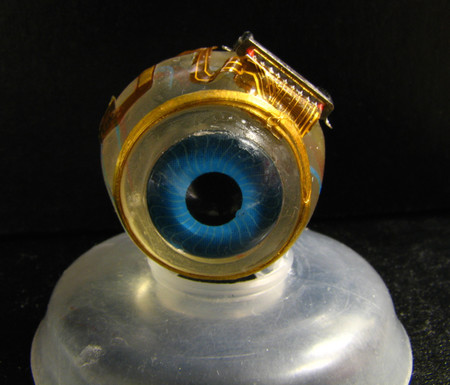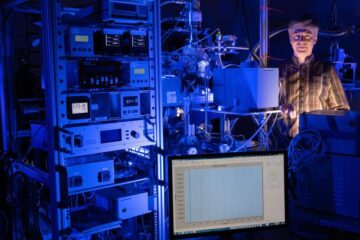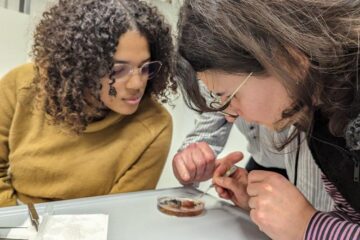Smart micro chips may optimise human vision

Implanting micro chips into eyes is reality. Optimising their (visual) performance is the focus of a current FWF project. © Shawn Kelly / Boston Retinal Implant Project
To date, chip-based retinal implants have only permitted a rudimentary restoration of vision. However, modifying the electrical signals emitted by the implants could change that.
This is the conclusion of the initial published findings of a project sponsored by the Austrian Science Fund FWF, which showed that two specific retinal cell types respond differently to certain electrical signals – an effect that could improve the perception of light-dark contrasts.
“Making the blind really see – that will take some time”, says Frank Rattay of the Institute of Analysis and Scientific Computing at the Vienna University of Technology – TU Wien. “But in the case of certain diseases of the eyes, it is already possible to restore vision, albeit still highly impaired, by means of retinal implants.”
PULSE EMITTER
To achieve this, microchips implanted in the eye convert light signals into electrical pulses, which then stimulate the cells of the retina. One major problem with this approach is that the various types of cells that respond differently to light stimuli in a healthy eye are all stimulated to the same degree. This greatly reduces the perception of contrast.
“But it might be possible”, Rattay says, “to stimulate one cell type more than the other by means of special electrical pulses, thus enhancing the perception of contrast.”
Within the framework of an FWF project, he and his team have discovered some promising approaches. Together with colleagues Shelley Fried of Harvard Medical School and Eberhard Zrenner of University Hospital Tübingen, he is now corroborating the simulated results with experimental findings.
SIMULATED & STIMULATED
With the help of a sophisticated computer simulation of two retinal cell types, Rattay and his team have discovered something very exciting. They found that by selecting specific electrical pulses, different biophysical processes can actually be activated in the two cell types. For example, monophasic stimulation, where the electrical polarity of the signal from the retinal implant does not change, leads to stronger depolarisation in one cell type than in the other.
“Depolarisation means that the negative charge that prevails in cells switches briefly to a positive charge. This is the mechanism by which signals are propagated along nerves”, Rattay explains. This charge reversal was significantly weaker in the other cell type. In their simulation, the team also found as much as a fourfold difference in the response of calcium concentrations in the two cell types to a monophasic signal.
ON AND OFF
“Calcium is an important signal molecule in many cells and plays a key role in information processing. For this reason, we specifically considered calcium concentrations in our simulation by considering the activity of membrane proteins involved in calcium transport”, explains Paul Werginz, a colleague of Rattay and lead author of the recently published paper. Concretely, the team devised models of two retinal cell types that are designated as ON and OFF cells.
ON cells react more strongly when the light is brighter at the centre of their location, while OFF cells react more strongly when the light is more intense at the edges. The two cell types are arranged in the retina in such a way as to greatly enhance contrast. The problem is that instead of light pulses, conventional retinal implants emit electrical pulses that elicit the same biochemical reactions in both cell types. Consequently, contrast perception is greatly reduced. However, Rattay's work shows that this needn't be the case.
SHAPE AS A FACTOR
Rattay's research group also found that the shape of the individual ON and OFF cells affect the way in which the signals are processed. For example, the different length of the two cell types is an important factor. This too, Rattay believes, could be an important finding that might help to significantly improve the performance of future retinal implants by modulating the electrical signals they emit. Rattay and his team are in hot pursuit of this goal in order to develop strategies that will allow many blind people to recognise objects visually.
Personal details
Frank Rattay is a professor at the Institute of Analysis and Scientific Computing of the Vienna University of Technology, where he heads the Computational Neuroscience and Biomedical Engineering group. For decades he has been publishing internationally recognised work on the generation and optimisation of artificial nerve signals.
Link
Original publication: Modeling the response of ON and OFF retinal bipolar cells during electric stimulation. Vision Research Dec. 2014. P. Werginz, H. Benav, E. Zrenner, F. Rattay. DOI: dx.doi.org/10.1016/j.visres.2014.12.002
http://www.ncbi.nlm.nih.gov/pubmed/25499837
Video showing the stimulation of nerve cells in the retina: https://www.youtube.com/watch?v=wQyURbqOTYg
Image and text available from Monday, 11 May 2015, from 10.00 am CEST at:
http://www.fwf.ac.at/en/research-in-practice/project-presentations/2015/pv2015-kw20
Scientific Contact:
Prof. Frank Rattay
Vienna University of Technology Institute of Analysis and Scientific Computing Wiedner Hauptstr. 8–10
1040 Vienna, Austria
T +43 / 1 / 58 801 – 10114
E frank.rattay@tuwien.ac.at
W https://www.tuwien.ac.at
Austrian Science Fund FWF:
Marc Seumenicht
Haus der Forschung
Sensengasse 1
1090 Vienna, Austria
T +43 / 1 / 505 67 40 – 8111
E marc.seumenicht@fwf.ac.at
W http://www.fwf.ac.at
Copy Editing & Distribution:
PR&D – Public Relations for Research & Education Mariannengasse 8
1090 Vienna, Austria
T +43 / 1 / 505 70 44
E contact@prd.at
W http://www.prd.at
Media Contact
All latest news from the category: Medical Engineering
The development of medical equipment, products and technical procedures is characterized by high research and development costs in a variety of fields related to the study of human medicine.
innovations-report provides informative and stimulating reports and articles on topics ranging from imaging processes, cell and tissue techniques, optical techniques, implants, orthopedic aids, clinical and medical office equipment, dialysis systems and x-ray/radiation monitoring devices to endoscopy, ultrasound, surgical techniques, and dental materials.
Newest articles

Peptides on Interstellar Ice
A research team led by Dr Serge Krasnokutski from the Astrophysics Laboratory at the Max Planck Institute for Astronomy at the University of Jena had already demonstrated that simple peptides…

A new look at the consequences of light pollution
GAME 2024 begins its experiments in eight countries. Can artificial light at night harm marine algae and impair their important functions for coastal ecosystems? This year’s project of the training…

Silicon Carbide Innovation Alliance to drive industrial-scale semiconductor work
Known for its ability to withstand extreme environments and high voltages, silicon carbide (SiC) is a semiconducting material made up of silicon and carbon atoms arranged into crystals that is…





















